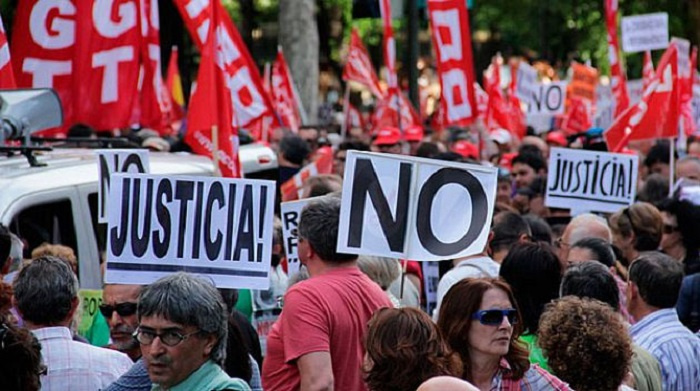Spain: A Turn from Right to Left?

Last week tens of thousands of people participated in a protest in Madrid which was sponsored by the leftist Podemos party. Has the victory of the leftists in Greece raised hopes for their political comrades in Spain? In order to answer this question, the present conditions of this country and its challenges must be studied.
The population of Spain is about 47 million and immigrants from Latin America, North Africa, Morocco and Algeria form 10% of it. Some of these immigrants live illegally in this country. Therefore, one of Spain’s problems is the issue of immigrants which has impacted the labor force. Spain has an old population; 15.3% are under 16 years of age, 44.1% between 16 to 44 years old and 40.7% are above 45 years old. In fact, Spain is the fifth most populated country in Europe. Tourism, construction and industry are the main sources of income for Spain. The economic growth of this country was 3.7% in 2007; the highest rate of economic growth in the EU in that year. This is while the average economic growth of the EU was 2.5%. Spain had more than 181 billion Euros worth of exports and 280 billion Euros worth of imports which indicated its growing economic situation. Spain attracts 59 million tourists every year and stands second after France in this regard.
But the US financial crisis affected the economic situation in Spain. Problems related to bank loans and interests gradually caused the housing crisis to become one of the most severe crises in Spain to the extent that the economic growth of this country became negative. It should be mentioned that the financial crisis in Spain must be considered within the framework of Europe’s crisis, Middle Eastern issues and the global economy. Nonetheless, this crisis led to a growing deficit and unemployment. There are 5 million unemployed at the present time in Spain who live under severe conditions. On the other hand, some states in Spain including Basque and Barcelona demand independence and exert numerous pressures on the government. Even though certain welfare measures were taken during Zapatero’s tenure as prime minister, who had leftist inclinations, for example if someone lost his job, he would be paid 500 to 600 Euros until the time when he found a new job, about 3 million jobs were lost during that period and workers were fired from their jobs.
There are different political groups, from nationalists to leftists, which are active in Spain. Right now the People’s Party leads the country and is confronted with numerous pressures from the socialists and communists. Recent protests are led by the Podemos party which has stated that the time has come to reach power. Of course, this is an exaggerated demand because other political parties have big shares in the political field of this country.
Today’s People’s Party is comprised of investors, intellectuals and people who are inclined towards the West and the US. This party has had bad luck and was not able to respond to people’s economic demands, thus, the lower class of the society seek a change in Spain’s power system. Except the communists, the socialist parties invited people to participate in these protests and 100000 people took part in them. These protests, along with the independence-seeking of some states, have pressured the central government to prevent the disintegration of this country. Although in Spain’s monarchial system, the king has a ceremonial role, all laws adopted by the congress must be signed by him.
Those people who have participated in the protests are mainly from the low to middle classes of the society. Economic problems have lowered people’s power to purchase goods. One of the causes is the injection of money into housing projects. Previous governments have spent a great amount of money for housing to the extent that, within two years, more than 800000 residential units were built. Industrialists also entered their money into the housing market but suddenly this market dropped.
Fluctuations in the oil price also have direct impacts on Spain’s economy. Furthermore, Spain is faced with its rivals in the European Union, including Britain and Italy. Therefore, they challenge this country in the EU. Besides, international developments such as the crisis in Ukraine and relations between Russia and the EU countries have also affected Spain. Spain had good relations with Russia and China but the present government has more tendencies towards the US.
The motivations behind the recent protests are not clear. Do some governments intend to weaken Spain in the EU?
In summary, part of the recent developments in Spain is caused by people’s dissatisfaction and part of it is impacted by international conditions, Middle Eastern developments, neighboring and North African countries and also by the pressures of the opposing parties. Israeli lobbies must be added to this list as well.
The last point which must be noted is that there is a semi-democracy in Spain. Different sectors of society have always staged demonstrations in front of the parliament to express their demands and have police protection. Thus, recent protests must not be considered as something new. Such protests also exist in big European countries such as France. That is why it can be said that so long as the problem between the EU and Russia is not resolved, Europe will be faced with different crises.

